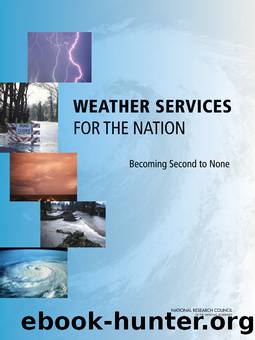Weather Services for the Nation: Becoming Second to None by Committee on the Assessment of the National Weather Service’s Modernization Program

Author:Committee on the Assessment of the National Weather Service’s Modernization Program
Language: eng
Format: epub
Tags: ebook
Publisher: Copyright 2012 by the National Academy of Sciences
Published: 2012-12-17T00:00:00+00:00
ADVISORY GROUPS FOR
TECHNOLOGICAL IMPROVEMENTS
Lesson 6 of the Committeeâs first report was that the various scientific and technical reports from independent advisory bodies were of substantial help to the NWS during the MAR. While the Committee was unable to be specific about how much external advice was appropriate, they nevertheless concluded that it was an important input to NWS and NOAA management. The Committee notes that creation of an NWS Advisory Committee was the first recommendation of the Fair Weather report (NRC, 2003a) and that subsequent reports have repeated that recommendation.
The Committee has considered several ways in which ongoing independent technical advice might be provided to the NWS, and this section presents them along with what the Committee judges to be the pros and cons associated with each.
1. Institutionalize the current Environmental Information Services Working Group (EISWG) subcommittee of the NOAA Science Advisory Board (NSAB) to make it the source of technical advice for the NWS.
2. Create a separate Federal Advisory Committee Act (FACA) committee solely devoted to providing technical advice to the NWS.
3. Create an independent, standing committee charged exclusively with providing ongoing scientific and technical advice to the NWS.
The advantage of the first option is that it is probably the simplest to set up. The âoverheadâ of creating a FACA committee has already been incurred, and the EISWG is already functioning. A possible drawback is that the EISWG subset of the NSAB cannot, because of its rather small membership, represent all of the areas or sectors in which advice and outside perspective would be of use to the NWS. The marginal cost of this option is likely only that associated with the meetings of EISWG that are distinct from those of the NSAB itself.
One advantage of the second option is that it could be structured to include a wide range of subject expertise and a wide range of representation of the various stakeholder groups in the weather, water, and climate enterprise. A second possible advantage might be that it would interact directly with NWS management. Possible drawbacks might include the substantial overhead and delay associated with creating a new FACA committee. The cost in dollars and staff time would be borne directly by the NWS, rather than by NOAA.
The third option probably has less overhead, because setting up an independent committee is a simpler process than setting up a FACA committee. It has the advantage, compared to the first option, of a broader range of expertise and stakeholder representation, but it is, of course, not under the control of NWS management regarding committee makeup. The costs are likely to be determined primarily by the size of the committee and the expected frequency of meetings, which might be as few as one or two per year. The costs would be borne directly by the NWS.
No matter which option for technical advice the NWS pursues, the advisory body would need expertise in both the physical and social science aspects of weather, water, and climate services, as well as expertise in systems engineering and infrastructure evolution.
Download
This site does not store any files on its server. We only index and link to content provided by other sites. Please contact the content providers to delete copyright contents if any and email us, we'll remove relevant links or contents immediately.
Man-made Catastrophes and Risk Information Concealment by Dmitry Chernov & Didier Sornette(5921)
The Revenge of Geography: What the Map Tells Us About Coming Conflicts and the Battle Against Fate by Kaplan Robert D(4035)
Zero Waste Home by Bea Johnson(3780)
COSMOS by Carl Sagan(3554)
Good by S. Walden(3488)
In a Sunburned Country by Bill Bryson(3486)
The Fate of Rome: Climate, Disease, and the End of an Empire (The Princeton History of the Ancient World) by Kyle Harper(3003)
A Wilder Time by William E. Glassley(2818)
Camino Island by John Grisham(2763)
The Ogre by Doug Scott(2631)
Organic Mushroom Farming and Mycoremediation by Tradd Cotter(2628)
Human Dynamics Research in Smart and Connected Communities by Shih-Lung Shaw & Daniel Sui(2466)
Energy Myths and Realities by Vaclav Smil(2438)
The Traveler's Gift by Andy Andrews(2409)
9781803241661-PYTHON FOR ARCGIS PRO by Unknown(2323)
Inside the Middle East by Avi Melamed(2305)
Birds of New Guinea by Pratt Thane K.; Beehler Bruce M.; Anderton John C(2226)
A History of Warfare by John Keegan(2186)
And the Band Played On by Randy Shilts(2129)
